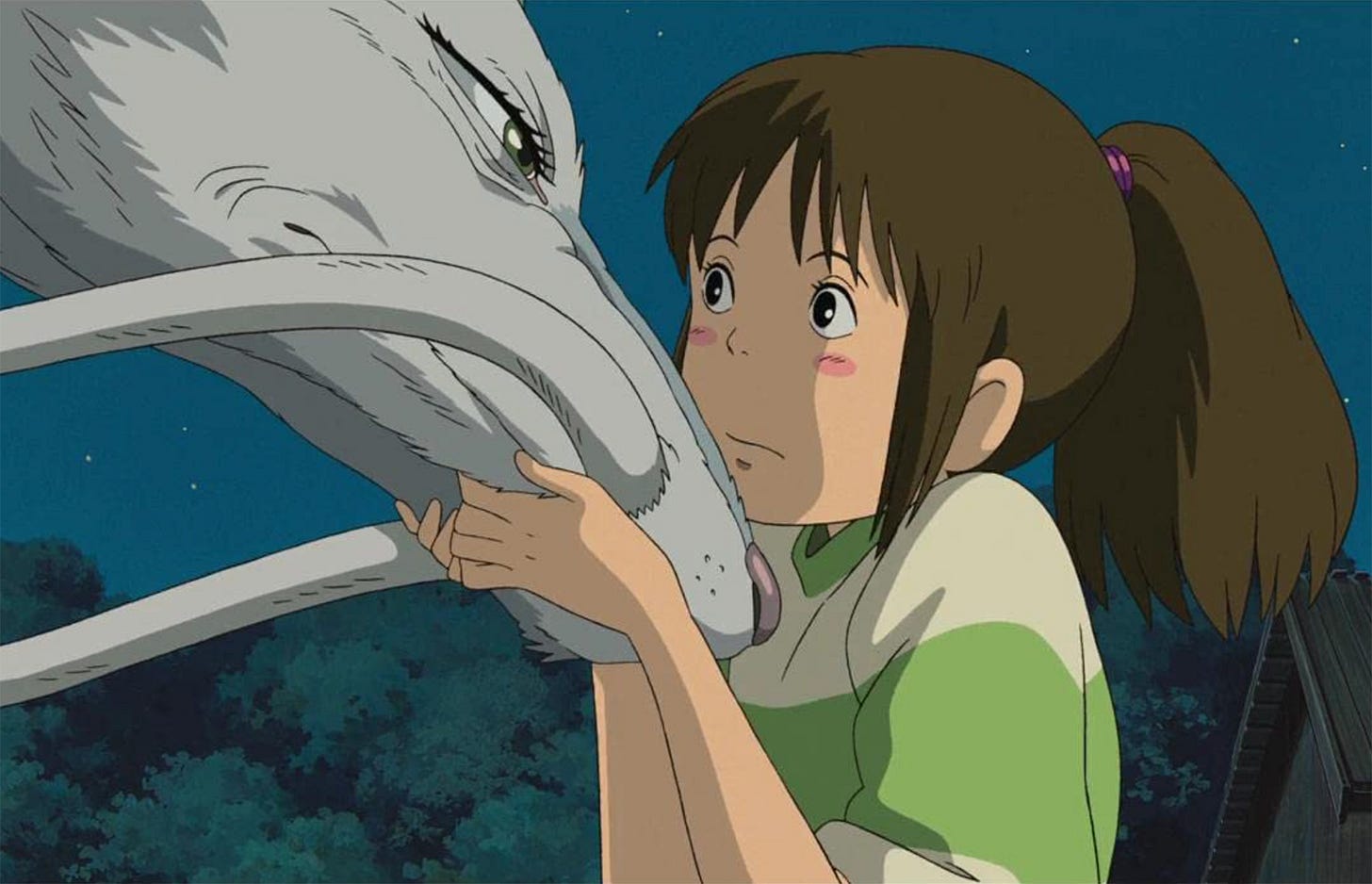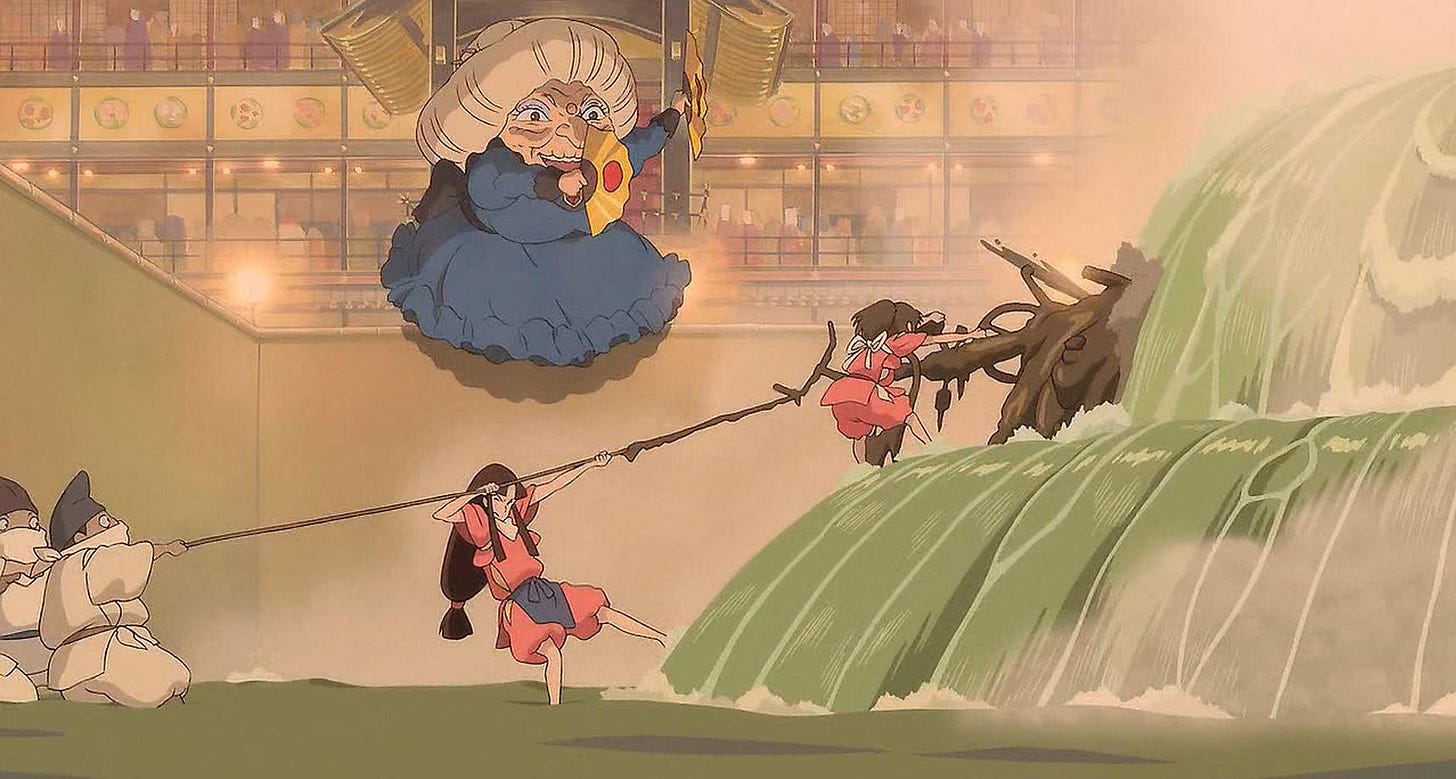We're the real Stink Spirits: Thoughts on Spirited Away
Spirited Away, more like Stinky Away, am I right?
I saw this film recently, it’s this little underground mega-hit called Spirited Away1. You know, the film that won the second-ever Academy Award for Best Animated Film and the film that’s the second highest-grossing movie of all time in Japan? Yeah, that one. Over the past month, I’ve been working my way through the films of Studio Ghibli2, many of which I’m seeing for the first time including Spirited Away.
Honestly, there are a million things I could talk about from the exquisite animation, the score and the sound design to the fact that it might just be the cutest film ever made3 (re: Boh). But, there is one scene more than any other that resonated with me. So, grab something to cover your nose because things are about to get stinky.
About halfway through the film, Yubaba’s bathhouse for spirits is visited by a being affectionately known as a ‘Stink Spirit4’, a giant blob of, uh, grossness. It sends everyone into a bit of a panic due to their concern that this new guest might make the whole place, well, stink. And, at first, our adorable protagonist Chihiro, or Sen as she’s dubbed by Yubaba, isn’t immune to the overwhelming odour. But, given that she’s a human and that means that Yubaba sees her as expendable, she’s given the task of tending to the putrid patron.
But she’s resourceful. Using an excessive amount of bath tokens she’s been given by No-Face, an icon in more ways than one, she calls for a herbal bath to soothe the new guest. In doing so, she notices that the Stink Spirit has something protruding from its side. Immediately, Yubaba ropes in every staff member in the bathhouse to pull out whatever is stuck inside ol’ Stinky. It turns out, our funky friend, has taken on a lot of old human trash including a bike amongst other things5. It is then revealed that beneath the layers of, um, grime, this poor pongy pal was a beautiful and majestic river spirit. It turns out, consuming all this trash was pretty bad for the river spirit, go figure.
Chihiro gets a reward from the river spirit in the form of a magic dumpling which she uses to great effect later in the film. This isn’t the only example of Miyazaki’s environmentalism in this film, nor his entire filmography. His thematic focus on the importance of the natural world and our symbiotic relationship with nature has been well documented, but no other scene has conveyed this theme to me more successfully than this one.
The way the Stink Spirit is animated, all oozing brown, eh, sludge, recalls images of oil spills in the ocean. The mess of rubbish that pours out of it clearly resembles the beds of any and all rivers in the world. Miyazaki leverages familiar imagery, albeit with a fantastical spin, to create a fascinating thematic parallel to real-world pollution.
It’s funny, it’s exciting and it’s rich with purpose. As Michael Leader and Jake Cunningham pointed out on their podcast Ghibliotheque6, this scene functions as a kind of short film. That the sequence could work in isolation speaks to Miyazaki’s storytelling genius, but I think that its beauty is in its thematic relationship to the scenes later in the film. Chihiro uses the magic dumpling to save the bathhouse from No-Face after they’d started rampantly consuming everything. Before once again using what is left to save the ailing Haku showing just how consequential Chihiro’s act of kindness towards the river spirit was.
It’s telling us how important our relationship with nature is to the survival of not only the planet but ourselves as well. Without first removing the pollution from the river spirit, destinkifying it if you will, Chihiro would not have been able to save the day and escape back to the real world. It’s a hopeful idea that runs through the heart of the film suggesting that saving the planet is still possible if we work together.
This scene acts as a clear metaphor for the way we treat our planet and, more specifically, our oceans7 but where Miyazaki and the Ghibli team really outdo themselves is in their ability to bring the audience in on the fun. The fact that the film immerses us through its subtle world-building8, helps us to feel as though we are a part of the triumph when the river spirit is finally freed. That’s its power. It’s not simply telling us that pollution is bad, it’s giving us the satisfaction of cleaning it up to make sure we believe it.
Anyway, thank you for coming to my Ted Talk, what are your favourite Ghibli films or moments? Go show your family Spirited Away and, while you’re at it, subscribe for more articles, essays and fiction from yours truly.
I had the privilege of seeing this masterpiece for the first time on the big screen at the BFI Southbank in London and, let me tell you, it looks sensational.
If you’re at all interested, follow me on Letterboxd to keep up with what I’m watching and check out my Ghibli rankings to see where I’ve gone totally wrong (or right, who knows?)
Incidentally, what I call my cat after he’s left us a little stink spirit in his litter box.
I can’t be the only one who found it incredibly satisfying in a kind of ASMR way when all that trash came pouring out, right?
This podcast is a big part of the reason why I’ve fallen in love with Ghibli, so go ahead and listen if you haven't. Here’s the Spirited Away episode.
The Great Pacific Garbage Patch, for example, is kind of incomprehensible.
The immersive world-building of Ghibli is covered beautifully in this video by Karsten Runquist and this video Asher Isbrucker.






